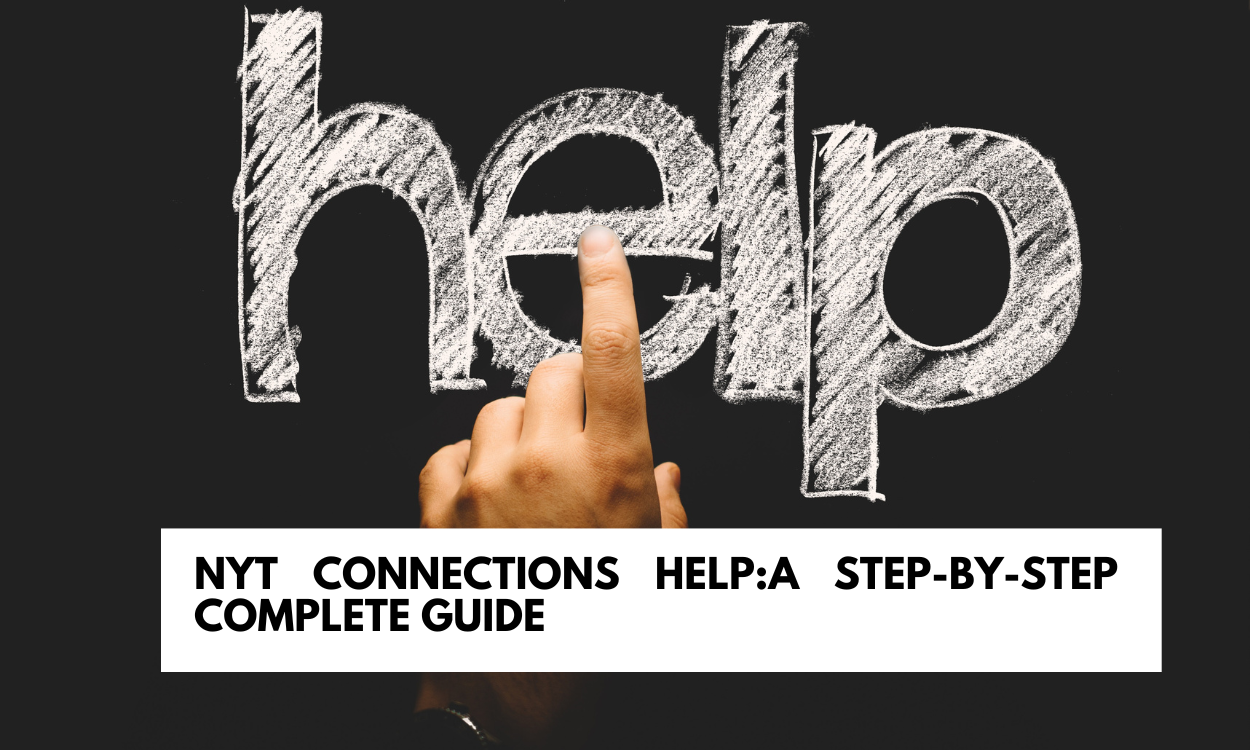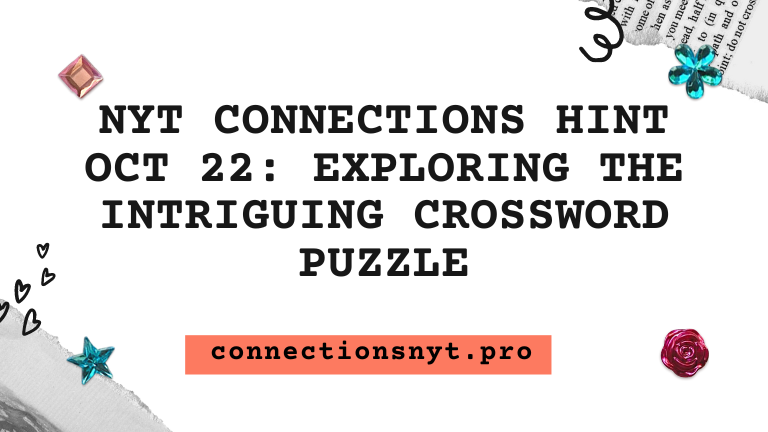NYT Connections Help:A Step-by-Step Complete Guide
NYT Connections Help:A Step-by-Step Complete Guide.The New York Times (NYT) Connections puzzle has quickly become a daily ritual for word game enthusiasts worldwide. This challenging yet addictive game tests players’ ability to identify connections between seemingly unrelated words. If you’re looking for help with NYT Connections, you’ve come to the right place. This comprehensive guide will provide you with strategies, tips, and insights to improve your puzzle-solving skills.
What is NYT Connections?
NYT Connections is a word puzzle game that presents players with a grid of 16 words. The objective is to identify four groups of four words, each sharing a common theme or connection. The game is designed to challenge players’ vocabulary, general knowledge, and ability to recognize patterns and associations.
Why NYT Connections is Popular
The game’s popularity stems from its perfect blend of accessibility and challenge. It’s easy to understand but difficult to master, making it appealing to a wide range of players. The daily nature of the puzzle also creates a sense of community, as players can compare their results and strategies.
Understanding the Basics of NYT Connections
Before diving into advanced strategies, it’s crucial to grasp the fundamental aspects of the game.
The Four Color Groups
NYT Connections uses four color-coded groups to represent different difficulty levels:
- Yellow (Easiest)
- Green (Easy)
- Blue (Medium)
- Purple (Hardest)
Understanding these difficulty levels can help you approach the puzzle more strategically.
How to Play NYT Connections
- Examine the 16 words presented in the grid.
- Identify four words that share a common theme or connection.
- Select these words and submit your guess.
- If correct, the words will be removed and color-coded.
- Continue until you’ve identified all four groups or run out of attempts.
Strategies for Solving NYT Connections
Now that we’ve covered the basics, let’s explore some effective strategies to help you solve NYT Connections puzzles.
Start with the Obvious
Begin by looking for the easiest connections, typically found in the yellow group. These often include:
- Common categories (e.g., colors, animals, professions)
- Words with obvious shared characteristics
- Well-known groups or sets
Look for Linguistic Patterns
Pay attention to word structures, prefixes, suffixes, or other linguistic features that might connect words. This can be particularly useful for the green and blue groups.
Consider Multiple Meanings
Remember that words can have multiple meanings or contexts. The purple group often relies on less obvious interpretations of words.
Use the Process of Elimination
As you identify groups, the remaining words become easier to connect. Use this to your advantage, especially for the more challenging groups.
Think Abstractly
For the most difficult connections, try to think beyond literal meanings. Consider idioms, cultural references, or abstract associations.
Common Themes in NYT Connections
Familiarizing yourself with frequently occurring themes can give you an edge in solving the puzzles.
Word Categories
Many groups are based on categories like:
- Animals
- Colors
- Professions
- Foods
- Sports
Linguistic Features
Look for words that share:
- Prefixes or suffixes
- Rhymes or similar sounds
- Parts of speech
Pop Culture References
Be prepared for groups related to:
- Movies and TV shows
- Music and musicians
- Books and authors
- Historical figures and events
Idiomatic Expressions
Especially in harder groups, words might be part of common phrases or idioms.
Advanced Techniques for NYT Connections
For those looking to take their Connections skills to the next level, consider these advanced techniques.
Analyze Word Relationships
Look beyond surface-level similarities and consider how words might be related in more complex ways:
- Cause and effect
- Part to whole
- Opposites or complements
- Sequential or chronological order
Utilize Word Association
Practice free association with the words in the grid. Sometimes, the connection might not be immediately logical but based on common associations.
Consider Cultural Context
Be aware of cultural references that might not be immediately obvious, especially if you’re playing in a country or culture different from your own.
Look for Patterns in Past Puzzles
While each day’s puzzle is unique, you might start to notice patterns or recurring themes if you play regularly. Use this knowledge to your advantage.
Common Pitfalls and How to Avoid Them
Even experienced players can fall into certain traps when solving NYT Connections. Here are some common pitfalls and how to avoid them:
Fixating on Initial Impressions
Don’t get too attached to your first ideas about connections. Be willing to reconsider and explore alternative groupings.
Overlooking Simple Connections
In search of complex connections, players sometimes miss the more obvious groups. Always consider straightforward connections, especially for the yellow group.
Ignoring the Difficulty Levels
Remember that the purple group is designed to be the most challenging. If you’re struggling to find a connection, it might belong to this group.
Rushing Through the Puzzle
Take your time to consider all possibilities. There’s no time limit, so use this to your advantage.
Tools and Resources for NYT Connections Players
While the puzzle is designed to be solved without external help, certain tools and resources can enhance your overall experience and improve your skills over time.
Online Dictionaries and Thesauruses
These can help you explore word meanings and relationships, especially for unfamiliar terms.
Word Association Websites
Practicing with word association tools can improve your ability to make quick connections.
NYT Connections Community Forums
Engaging with other players can provide new perspectives and strategies.
Puzzle Analysis Websites
Some websites offer detailed breakdowns of past puzzles, which can be educational.
The Psychology Behind NYT Connections
Understanding the cognitive processes involved in solving NYT Connections can help you approach the puzzle more effectively.
Pattern Recognition
The game heavily relies on your brain’s ability to recognize patterns and categorize information.
Cognitive Flexibility
Success in Connections often requires shifting between different ways of thinking about words and their relationships.
Working Memory
Keeping track of potential connections and eliminating possibilities exercises your working memory.
Insight Problem Solving
The “aha!” moment when you suddenly see a connection is a classic example of insight problem solving.
Improving Your NYT Connections Skills Over Time
Like any skill, your ability to solve NYT Connections puzzles can improve with practice and the right approach.
Play Consistently
Try to solve the puzzle daily to build your skills and familiarity with common themes.
Analyze Your Mistakes
When you get a group wrong, take time to understand the correct connection and learn from it.
Expand Your Knowledge Base
Read widely across various subjects to broaden your general knowledge, which can help with diverse puzzle themes.
Challenge Yourself
Once you’re comfortable with the main game, try to solve it with fewer attempts or within a time limit.
The Social Aspect of NYT Connections
NYT Connections has fostered a vibrant community of players who enjoy sharing their experiences and strategies.
Comparing Results
Many players share their daily results on social media, creating a sense of friendly competition.
Discussing Strategies
Online forums and social media groups provide spaces for players to discuss strategies and particularly challenging puzzles.
Collaborative Solving
Some players enjoy working on the puzzle together, either in person or virtually.
NYT Connections for Different Skill Levels
The game appeals to players of various skill levels, from beginners to seasoned wordsmiths.
Tips for Beginners
- Focus on identifying the yellow group first
- Don’t be afraid to use the shuffle button to see words in a different arrangement
- Learn from your mistakes and the correct answers each day
Challenges for Advanced Players
- Try to solve the puzzle with minimal attempts
- Challenge yourself to identify the purple group first
- Compete with friends for the fastest solving time

The Future of NYT Connections
As the game continues to grow in popularity, we might see some exciting developments.
Potential New Features
- Themed weekly or monthly puzzles
- Collaborative multiplayer modes
- Integration with other NYT games
Educational Applications
The puzzle’s format could be adapted for educational purposes, teaching subjects like vocabulary, history, or science.
Technological Advancements
Future versions might incorporate AI to generate personalized puzzles or provide more sophisticated hints.
Conclusion: Mastering NYT Connections
NYT Connections is more than just a daily word puzzle; it’s a journey of continuous learning and improvement. By understanding the game’s mechanics, employing effective strategies, and learning from each day’s challenge, you can enhance your skills and derive even more enjoyment from the game.
Remember, the true joy of NYT connections lies not just in solving the puzzle, but in the moments of discovery, the satisfaction of making clever connections, and the sense of community shared with fellow players around the world.
Whether you’re a newcomer seeking help or a seasoned player looking to refine your approach, the world of NYT Connections offers endless opportunities for growth and entertainment. So, armed with the insights and strategies from this guide, approach each day’s puzzle with confidence, curiosity, and an open mind.
Happy connecting!
FAQs
What is NYT Connections?
NYT Connections is a daily word puzzle game where players group 16 words into four categories of four words each, based on common connections or themes.
How do you play NYT Connections?
Players select four words they believe are connected and submit their guess. If correct, the words are removed from the list and placed in their respective group. If incorrect, a mistake is recorded.
Can you play NYT Connections more than once a day?
No, you can only play the game once per day. The next puzzle is available at midnight.
What happens if you make a mistake?
You are allowed a limited number of mistakes. Each incorrect guess reduces your remaining chances, and after four mistakes, the game ends.
Are there different difficulty levels?
Yes, the groups have different difficulty levels indicated by colors: yellow (easy), green (moderate), blue (challenging), and purple (most difficult).
Can you shuffle the words?
Yes, you can shuffle the words as many times as needed to help find the connections.
Is there a hint system?
Yes, if you are one word off, the game provides a hint indicating that one of your selected words is incorrect.



![Connections NYT Hint Forbes Today [2024]](https://connectionsnyt.pro/wp-content/uploads/2024/05/connections-nyt-hint-forbes-today-1.png)


![What Connects These Four Loose Split Dead Book NYT? [2024]](https://connectionsnyt.pro/wp-content/uploads/2024/04/What-Connects-These-Four-Loose-Split-Dead-Book-NYT.png)
